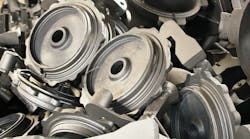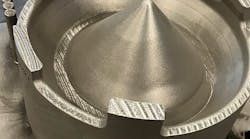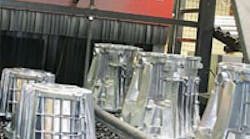Schleuderraeder Koenig Precision Co. is a machining job shop that has specialized in finishing castings since 2000, offering degating, manual deburring, and product quality control. Beginning in 2006 Koenig, started operating a high-volume shot blasting system. The investment became necessary to serve an automotive customer that had awarded a contract to Koenig for deburring and surface finishing of aluminum diecast torque converter and transmission housings.
Rolf Koenig and Harald Zeiler, the management team at Koenig Precision, researched the blasting systems available among the leading equipment manufacturers. According to Rolf Koenig, “At Rosler we received extensive technical advice, and they provide us with excellent technical support.”
Shot blasting these diecastings is not easy. It requires the 360° cleaning of a total of nine different aluminum diecastings weighing from 5,000 to 8,500 grams, and up to 400 mm high. All parts are “cup-shaped,” which presents a risk for media carry-out. The infeed cycle time is 12 sec/part.
Rosler (www.roslerusa.com) developed the optimum blast process for these parts through an extensive series of trials at its demonstration lab in Germany. The result is the RDGE 1000-8 wire mesh belt machine, which offers eight high-performance Hurricane blast wheels that ensure an excellent and consistent finish of the complex products. Its 1,000-mm wide wire-mesh belt is divided into two tracks.
Another design feature is the unload system of the shot blast machine: It allows the automatic and consistent removal of all blast media that might be carried out with the “cupshaped” parts. The reclaimed blast media is automatically returned to the blast machine.
Zeiler explains that “the special angle at which the blast wheels are mounted ensures that all parts contours and cavities are blasted with the same intensity, preventing any ‘shadowing.’ The blast results are excellent,” he adds. Currently Koenig Precision is processing 2,500 parts a day, which is just half of the machine’s potential capacity.










